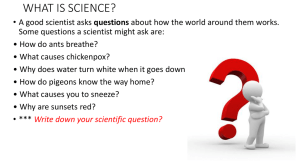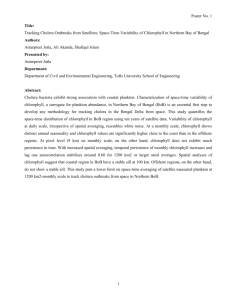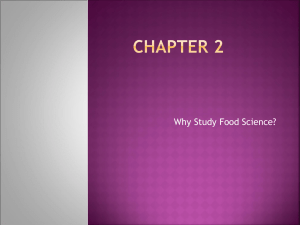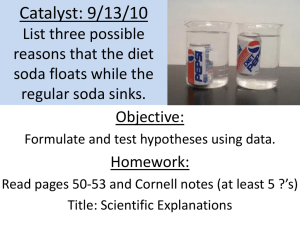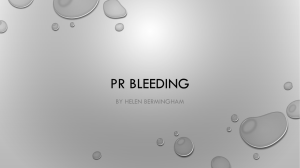BLC9_Rawle_Thinking Like a Scientist
advertisement
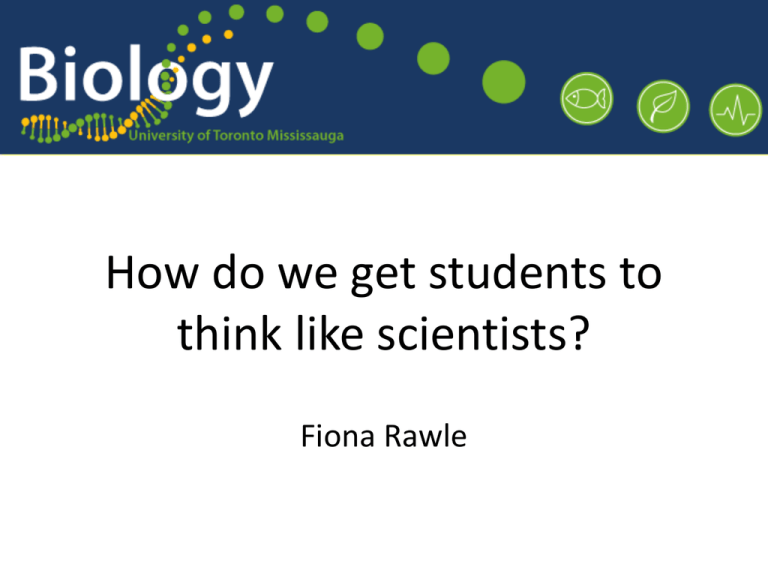
How do we get students to think like scientists? Fiona Rawle Curriculum Mapping Project • Undergraduate curriculum mapping: – Learning Outcomes – BOK Map (Body of knowledge – concepts) – Skill Map (Biology Skill Set) • Every LO gets mapped accordingly to: – Taught, Assessed (-/T/A) – Introduced, Reinforced, Advanced (I/R/A) • Using the review of the curriculum map to inform course redesign Core Courses BIO152 Introduction to Evolution and Evolutionary Genetics BIO153 Diversity of Organisms BIO204 Introduction to Physiology BIO205 Ecology BIO206 Introductory Cell and Molecular Biology BIO215 Laboratory in Molecular Biology and Genetics BIO207 Introductory Genetics BIO360 Biometrics I BIO152 • We need to lay the foundation for future learning. • Students need to know how science works, rather than learning lists/collections of facts. • Need to learn to think like scientists…and later, think like scientists to learn. 1. “Thinking Like a Scientist” Introductory Module 6. Active Learning Exercises in Lecture 2. Case Study Based Tutorial Sessions Introductory Biology Course Re-Design 5. Scientific Literacy Assignment 3. Inquiry Based Labs 4. “Science vs. Pseudoscien ce” Lecture Examples Nature of science Process of science Scientific Reasoning Skills The process of science exploration is not about “right answers” Thinking Like A Scientist Module What is science? Who does science? Process of Science Science around you Why should you care? Nature of science Processes of science Roles of evidence Roles of theory Generation of hypotheses Interpretation of data Creation and use of models What do you think of when you hear the word “scientist”? -old -smart -conducts experiments Sciencebuddies.org www.understandingscience.org What’s “wrong” with the simplified, linear scientific method? • implies that scientific studies follow an constant, one-way recipe. (Reality: different order; different activities; repeats). • implies that science is done by individual scientists alone. (Reality: different people might do different parts; collaboration; scientists actually talk to one another.) • implies that science has little room for creativity. (Reality: process of science is exciting, dynamic, and unpredictable). • implies that science concludes. (Reality: investigations are often ongoing; conclusions are reversible). From: www.understandingscience.org www.understandingscience.org www.understandingscience.org www.understandingscience.org www.understandingscience.org Science vs Pseudoscience Science vs Spin www.understandingscience.org Chlorophyll Supplementation • “…take chlorophyll supplements to oxygenate your bowel” (See expanded description of this chlorophyll example in Bad Science by Ben Goldacre) Questions • • • • Will chlorophyll oxygenate your bowel? Does chlorophyll contain oxygen? Can photosynthesis occur in your bowel? Do you want oxygen in your bowel? Students assist in developing conceptual framework Student generated steps… • Question the rationale. • Question the source. • Come up with a question. • Come up with a hypothesis. • Design a controlled experiment to test the claim. • “Contains stem cells and DNA technology” • “Replace aged cells with younger cells” • “Repair damage” • “Reverse the aging process” “Detox Foot Bath” 1. 2. 3. 4. 5. 6. 7. Rationale Source Question Hypothesis Prediction Experiment More Questions How will we assess this? • Concept assessments / inventories • NOSCA (Nature of science concept assessment) Acknowledgements & Resources • Mindy Thuna, Science Librarian • Cleo Boyd, Academic Skills Centre • www.understandingscience.org • Koslowski, B. (1996). Theory and evidence: The development of scientific reasoning. Cambridge, MA: MIT Press. • Zimmerman, C. (2000). The development of scientific reasoning skills. Developmental Review, 20, 99–149. • Link to “experiment” on detox foot bath, used as a class example for critiquing experiments – http://www.youtube.com/watch?v=YlvUHukhT9Q

